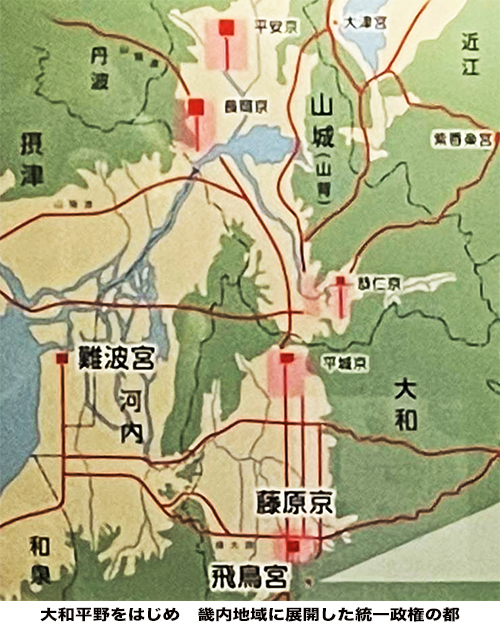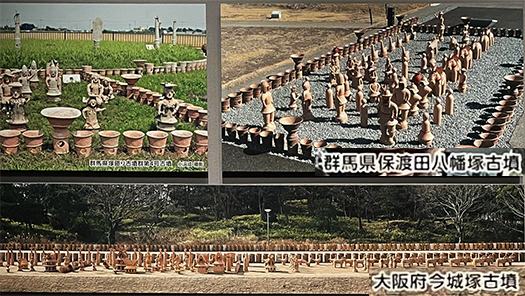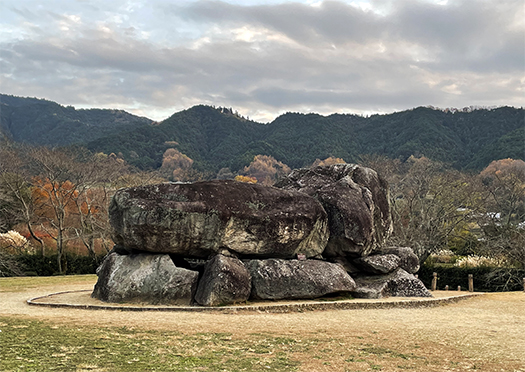
きのうは日本国家成立の頃の海の交通路を再探訪。
古代史を考えるようになっていつも不思議だったのはどうして倭国はあんなにも朝鮮半島にこだわっていたのか、ということ。
半島最南端の多島海地域に任那という「衛星国家」も存在していた。当然経済的な強い利権関係がそこにあって、その確保に強い執着を持っていたのだろう。
やはり水田農耕経済を発展させる鉄などの経済利器の伝播の道だったことがこうした執着の原因とみなせる。
国土の気候風土性もあって農業耕作地としては韓半島地域よりも数段適地だった。耕作適地を所有できるという欲望・強い憧憬からアジア大陸からの移住者もニューフロンティアとして列島を目指したのだろう。
やがて山陰地方を嚆矢として鉄鉱石の国内生産が可能になり、北九州地域からの鉄器などの文化流入に依存する社会ではなくなっていく。
『出雲国風土記』には、飯石郡の条に”波多小川。鉄あり”仁多郡の条には”以上の諸郷より出す所の鉄、堅くして、もっとも雑具造るに堪ふ”とある。「鉄あり」とは川から砂鉄を採ったこと「諸郷より出す所の鉄」とは各郷で鉄生産が行われていたことを示しています。平安時代の『政事要略』の記載によると、地子雑物(地代)として鉄や鍬が定められていたのは出雲、伯耆、備後、備中であることから、これらの地域が古代における鉄の産地として知られていたと考えられます。〜引用「出雲国たたら風土記」より要旨。
国内政治的には大和地域に「東征」したという伝承を強く持つヤマト王権が徐々に全国支配を強めて行くことになる。半島地域は統一がなかなか進展しなかったのに、どうして日本列島ではヤマト王権の支配強化が進んだのか、対比的で面白い。たぶん魏志倭人伝に書かれた「国」乱立気味の北部九州、桃太郎伝説を持つ岡山・吉備の王権、出雲を中心とする環日本海王権などなど小国分立はある時期までは韓半島と同様の状態だったように思える。


写真は日本各地の首長墳墓古墳を飾った埴輪と大和平野にある蘇我氏の墳墓と伝わる石舞台。
北部九州などは玄界灘の対岸の任那地域同様、各地で権力分散傾向。韓半島国家は中国の大陸王朝権力との複雑極まりない権謀術数があって、分裂が常態化していた。対して日本社会では「東征後」のヤマト王権の支配権の確立が進んだのは、この中国の王朝との遠さが統一を進める方向に働いたのだと想像できる。その後の東アジア外交でこの統一国家日本という存在感は大いに外交的効果があったと思う。また、そのことがヤマト王権の国内支配にとって強いパワーにもなったと思える。
ヤマト王権の中心人物たちにとって当初基盤であった北部九州では列島の「統一国家」形成は不可能であり、その王権中心地域として地政学的・戦略的に大和平野を強く狙った結果なのだろう。その戦略の正しさにやがて出雲などの他の王権は服従して行くことになった。
English version⬇
Yamato Chosen as Capital Based on Geopolitics by Emperor Jinmu (The 37,000 Year History of the Japanese Archipelago, Vol. 54)
Japan continued to intervene in the peninsula in search of iron. Eventually, Japan produced its own iron. This enabled Japan to conduct independent diplomacy with China. …
Yesterday, we re-explored the sea transportation routes around the time of the establishment of the Japanese nation.
When I began to think about ancient history, I always wondered why the Japanese were so obsessed with the Korean peninsula.
There was also a “satellite state” called Rinna in the southernmost peninsula in the Archipelago region. Naturally, there was a strong economic interest there, and Japan must have been obsessed with securing it.
This obsession can be attributed to the fact that Nana was the route for the spread of iron and other economic tools that developed the paddy field and agricultural economies.
The climate of the region was more suitable than that of the Korean peninsula for agricultural cultivation. The desire to own land suitable for cultivation and the strong yearning for such land may have led migrants from the Asian continent to the archipelago as a new frontier.
The San’in region became the first to produce iron ore domestically, and the society was no longer dependent on the influx of iron tools and other cultural products from the Kitakyushu region.
The Izumo no Kuni Fudoki (Izumo Province Climate Record) mentions in an article on Iishi County, “Hata Ogawa. In the “Izumo no kuni fudoki” (Izumo Province Fudoki), an article from Iishi County states, “There is iron in Hata Ogawa,” and an article from Nita County states, “Iron from the above villages is hard and most suitable for making miscellaneous tools. The phrase “iron is available” indicates that iron sand was extracted from the river, and “iron from various villages” indicates that iron production was carried out in each village. According to the Heian-period “Seijo Yosaku,” iron and hoes were stipulated as jiko zoshimono (land rent) in Izumo, Hoki, Bingo, and Bichu, suggesting that these areas were known as iron-producing regions in ancient times. 〜The summary from “Izumo-no-kuni Tatara-fudoki” quoted above.
In terms of domestic politics, the Yamato royal power, which is strongly believed to have “conquered” the Yamato region, gradually strengthened its control over the whole country. It is interesting to contrast why the unification of the peninsula region did not make much progress, while the Yamato kingdom strengthened its rule in the Japanese archipelago. It seems that until a certain point in time, the division of small states, such as Northern Kyushu, where the “kingdoms” described in the Wei-Shi-Wa-jin-Den are in disarray, the royalty of Okayama and Kibi, which have the Momotaro legend, and the Japan Sea Rim royalty centering on Izumo, were in a similar state to that of the Korean peninsula.
The photo shows haniwa terra-cotta tombs decorating the tombs of chiefs throughout Japan and a stone stage in the Yamato Plain, which is believed to be the tomb of the Soga clan.
The northern part of Kyushu, as well as the Nina region on the other side of the Genkai Sea, tends to decentralize power in various parts of Japan. The Korean peninsula had an extremely complicated power struggle with the dynastic power of the Chinese mainland, and division was the norm. In contrast, in Japanese society, the establishment of the Yamato kingdom’s dominance “after the Eastern expedition” progressed, and we can imagine that this remoteness from the Chinese dynasties worked in the direction of advancing unification. I believe that this presence of a unified Japan had a great diplomatic effect in subsequent East Asian diplomacy. It also seems to have been a powerful force for the Yamato dynasty’s dominance in Japan.
Posted on 12月 30th, 2022 by 三木 奎吾
Filed under: 歴史探訪







コメントを投稿
「※誹謗中傷や、悪意のある書き込み、営利目的などのコメントを防ぐために、投稿された全てのコメントは一時的に保留されますのでご了承ください。」
You must be logged in to post a comment.